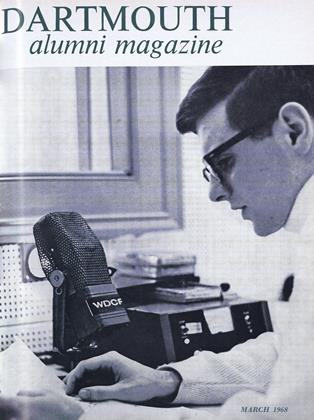By Paul Sjeklocha and IgorMead '51: Berkeley and Los Angeles:University of California Press, 1967. 213pp. $15.
Unofficial Art in the Soviet Union presents a study of visual arts not officially blessed by the Soviet establishment. Sjeklocha and Mead toured the U.S.S.R. for eight months with the American Graphic Arts Exhibition and interviewed a number of artists working in areas unapproved by the government.
The visual arts have always been tightly controlled by the Russian government, certainly more so than literature, drama, or music. Both icons and political posters have provided the state a useful tool in communicating official beliefs and providing a "guided inspiration" to the common man. "The work of the unofficial artists, on the other hand," the authors state, "is generally non-political. Indeed its lack of concern with the furtherance of the Party line is its gravest error in the eyes of the Soviet government." Some of the unofficial artists remain in the Artists Union and yet avoid "official" subjects by concentrating on illustrations for "non-political" books on Russian folklore, medieval history, and children's stories. Others can be best termed "social outcasts" whose abstract and experimental works are created for personal satisfaction and private sale. The outcasts' meager earnings often force them to live under conditions rivalling the most squalid in the East Village.
The 30 color and 67 black and white reproductions range from stylized still lifes, portraits, icons, and landscapes to collages and abstractions. Several works are distinctly religious in theme; many are reminiscent of western artists such as Klee, Modigliani, and de Kooning.
The authors avoid any involved aesthetic appraisal of these works; they have seen a fraction of what is being created and are not in a position to pass judgement from their sampling. Certainly it is encouraging that an unofficial movement of such proportions exists at all. Unofficial Art in the SovietUnion admirably presents material never before compiled in book form and should be required reading for anyone following the progress of art in the Soviet Union.
Assistant Professor of Russian Language andLiterature at Dartmouth, Mr. Kalbouss ispresently teaching two courses, Folk Literature and the Formal Arts and RussianDrama, and a seminar, The Russian Symbolist Movement.
 View Full Issue
View Full Issue
More From This Issue
-
 Feature
FeatureNew Edition of Webster Papers
March 1968 By John Hurd '21 -
 Feature
Feature"Intensive" Is the Word for It
March 1968 By Joan Hier -
 Feature
FeatureWDCR Reports
March 1968 By LAURENCE G. BARNET '68 -
 Feature
FeatureDrama Critic
March 1968 -
 Feature
FeatureWhite House Fellow
March 1968 -
 Feature
FeatureDiscount Dynamo
March 1968 By MARIE WHITE








